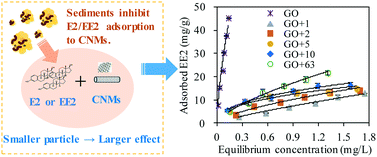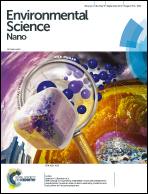Sediments inhibit adsorption of 17β-estradiol and 17α-ethinylestradiol to carbon nanotubes and graphene oxide†
Abstract
Increasing use of carbonaceous nanomaterials (CNMs) in many industrial and commercial applications has raised concern over their potential environmental impacts. However, little is known about how the released CNMs could interact with other contaminants in aquatic environments. In this study, the effects of sediment particle size (<1 μm, 1–2 μm, 2–5 μm, 5–10 μm, and 10–63 μm) and organic matter (OM) on adsorption of 17β-estradiol (E2) and 17α-ethinylestradiol (EE2) to carboxylated multi-walled carbon nanotubes (CNTs) and graphene oxide (GO) were investigated using batch adsorption experiments in combination with microscopic, spectroscopic, and computational techniques. The adsorption of E2 and EE2 to CNMs was much stronger than that to the sediments, resulting from π–π interactions and hydrogen bonding, as confirmed with density functional theory calculations. Nonetheless, the presence of sediments inhibited E2/EE2 adsorption to CNTs or GO, and the inhibition effect increased with decreasing sediment particle size. This inhibition effect resulted from the attachment of CNMs to the sediment surface and subsequent blockage of the adsorption sites on CNMs. The removal of OM in the sediments enhanced the inhibition effect, likely due to stronger attachment of CNMs on OM-free sediments. These observations were corroborated by microscopic visualization and DLVO calculations. Our results provided new insights into the effect of sediments on contaminant adsorption by CNMs, as modulated by sediment particle size and OM.



 Please wait while we load your content...
Please wait while we load your content...